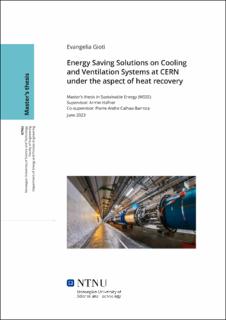| dc.contributor.advisor | Hafner, Armin | |
| dc.contributor.advisor | Calhau Barroca, Pierre Andre | |
| dc.contributor.author | Gioti, Evangelia | |
| dc.date.accessioned | 2023-10-22T17:19:42Z | |
| dc.date.available | 2023-10-22T17:19:42Z | |
| dc.date.issued | 2023 | |
| dc.identifier | no.ntnu:inspera:142431124:92369595 | |
| dc.identifier.uri | https://hdl.handle.net/11250/3097930 | |
| dc.description.abstract | M ̊alet med denne rapporten er ̊a kartlegge de eksisterende systemene ved CERN campus og ̊a foresl ̊a
alternative, mer energieffektive løsninger. Det vil spesifikt fokuseres p ̊a ̊a undersøke eksisterende kjøle-
og ventilasjonssystemer i et typisk kontornettverk. Gjennom denne studien vil oppgraderingsalterna-
tiver foresl ̊as, primært med tanke p ̊a ̊a bytte av arbeidsmedium samt identifisering av kompatible
løsninger for gjenvinning av spillvarme.
For ̊a oppn ̊a dette m ̊alet, anses en litteraturstudie som viktig for ̊a gi en dyptg ̊aende innsikt i de
mange komponentene i og de ulike typene av dagens varme- og kjølesystemer. I tillegg er en grundig
analyse av fem arbeidsmedier presentert. Her sammenlignes termofysiske egenskaper, driftskostnader
og bærekraftsindikatorer.
Videre følger en beskrivelse av dette prosjektets hovedstudie og metodikken som er brukt for ̊a løse
oppgaven p ̊a en optimal m ̊ate. Systemet er modellert ved hjelp av Modelica-syntaks og simulert ved
hjelp av programvaren Dymola® basert p ̊a data samlet inn fra det installerte nettverket. Simuleringen
inneholder to forskjellige scenarier. I det første scenarioet er arbeidsmediet som brukes i dag, R134a,
er benyttet. Mens i det andre scenariet er dagens arbeidsmedium erstattet med CO2. Begge scenariene
er undersøkt med b ̊ade konstante og dynamiske laster.
Resultatene av de to modellene undersøkes og sammenlignes. Deretter gis det anbefalinger for yt-
terligere forbedringer av systemet. | |
| dc.description.abstract | The aim of this report is to map the already existing systems at the CERN campus and propose
alternative, more energy efficient solutions. The investigation will be focused specifically on the
examination of the existing cooling and ventilation systems in a typical office network. Through this
research, upgrade options will be put forth, primarily in the context of changing their working fluid
and identifying compatible solutions for waste heat recovery.
In order for this objective to be fulfilled, a literature review is deemed important to give in-depth
research into the many components and the variable types of the present heating and cooling systems.
In addition, a thorough analysis of five working fluids is provided, along with a comparison of their
thermophysical characteristics, operational costs, and sustainability indicators.
The work follows with the description of the main study case of this project and the methodology used
to address the task in an optimal way. The system is modelled using Modelica syntax and simulated
using Dymola® software solvers based on data gathered from the currently installed network. The
simulation features two distinct scenarios utilizing the currently used R134a refrigerant and its CO2
replacement. Each case is looked into with both constant and dynamic loads.
The outcomes of the two models are contrasted and examined, and then recommendations are made
for further system improvements. | |
| dc.language | eng | |
| dc.publisher | NTNU | |
| dc.title | Energy Saving Solutions on Cooling and Ventilation Systems at CERN under the aspect of heat recovery | |
| dc.type | Master thesis | |
